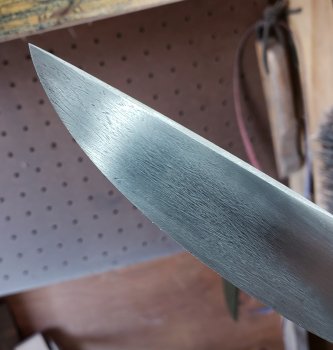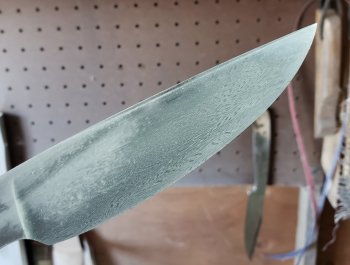It is alloy banding, and wow! It is a really heavy case of it! You can get rid of it with careful normalizing. I would be very curious to know what steel it is and exactly how you heat treated it, every heat from the time you received the steel. When traditionally poured steel is cooled in the mill production process the iron tends to solidify at a different rate than the alloying elements present. This creates the formation of crystalline structures that look like ferns or trees, kind of like frost crystals on glass in the winter, these metallic crystal formations are known as "dendrites." Left as is, the steel ingot would be a inhomogeneous and unpredictable mess, due to this segregation. There is no way to actually undo this issue entirely but what they can do it make the issue anisotropic (single directional) rather that isotropic (a problem in all directions). This is accomplished by heavy reduction by rolling, thus drawing the dendrites lengthwise through the bar of steel, giving steel its directional properties.
However the segregation effects are still there and when we heat the steel, the carbide will want to bunch up in these inhomogeneous areas. Normally we don't see this too much on the macroscopic level, but if we get too "creative" with our heating and cooling rates, we can gather the carbide up so heavily that it becomes a visible pattern in those alloy bands. The answer is to normalize on a level to totally redistribute the carbide more evenly in the steel. You will often see it on blades with hamons and the edge will not have the banding. This is because the edge is martensitic, thus all of the carbon is in a more homogenous solution but the spine is pearlitic which, by definition, is separated carbide. The habuchi area at the top of the hardened zone will often have the most pronounced banding due to the pro-eutectoid phases that are precipitated there before the pearlite forms.
Now for the question that I know is coming as it is always the question number two, after "what is it"- will this effect the blade? Not really, unless it is too pronounced, particularly at the edge. If you tested the blade to destruction you would find some inconsistencies in tensile and impact properties, but nothing that would bother blade use that much. But if the segregation is heavy at the edge you will be limited on what type of applications the edge can be used for. The ragged edge that could result will make the blade cut more aggressively in a draw cut, but will kind of suck for fine push cuts. Such a blade would probably do alright for a hunting knife, but would be like taking a blender to your face for a on a straight razor, and I personally wouldn't like it for fine cutting kitchen knives.




